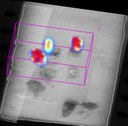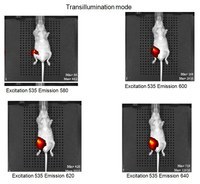Optical Imaging
Fluorescence Imaging

VisEn FMT 2500 LX (Fluorescence Molecular Tomography) is a dedicated in vivo fluorescence tomographic imaging system for rodents, which allows investigators to acquire calibrated quantitative 3D images. The FMT 2500 LX is operating under a four near-infared (NIR) -channels format, in which it is capable to excite fluorophores emitting 660-, 700-, 775-, and 805-nm wavelengths (excitation lights at 635, 670, 746, and 790 nm, respectively). By having multiple excitation channels, this construction improves the flexibility of the system. Moreover, with the build-in advanced 3D image reconstruction algorithms, the FMT 2500 LX allows investigators to accurately record and quantify in vivo tomographic fluorescence site-specific light emission from a target region. Because of the tomographic imaging capability, this unique feature also allows easy multi-modality fusion studies.

The principal sources of excitation lights are produced by four separate laser diodes (emitting photon radiation at 635-, 670-, 746-, and 790-nm wavelengths). During a data acquisition phase, a subject will be administered with a fluorescence-dyed labeled compound and a near-infrared (NIR) transilluminated laser diode is automatically positioned from the ventral side of the subject and the excited fluorescence output could then be collected at the dorsal side of the subject via a thermoelectrically cool CCD camera. Multiple calibrated projections of the excited fluorescence output from the subject could be recorded and the tomographic images could then be reconstructed from the multi-projected images. The output tomographic images could be exported or saved in a standardized medical file format called DICOM (Digital Imaging and Communications in Medicine) for post-processing. The FMT 2500 LX also has a built-in subject-holding cassette compartment and pressurized isoflurane inlet and outlets for easy subject loading and maintenance for imaging.
FMT modality is a unique optical imaging device which offers principal investigators with unprecedented opportunities to acquire 3-dimensional image data. Three-dimensional dataset allows pinpointing an exact location of the light emission sources, such as a tumor (similar to PET and SPECT) and notwithstanding this feature also allows researchers to make exact quantitative analysis on their target tissues. For example, using Prosense750 and MPSense680, FMT 2500 LX was used to image disease progression of rheumatoid arthritis in mice. The modality effectively discriminated and isolated regional recovery during the study's therapeutic phase. The 3D-mode could pinpoint the amount (or volume) of recovery.
Bioluminescence Imaging

Biospace Lab Photon Imager is a dedicated low light level in vivo optical modality for bioluminescent and fluorescent imaging. Comparing to other bioluminescent/fluorescent systems, the Photon Imager has two unique features, making it an extremely useful device for investigators who are interested in high-throughput studies as well as absolute and kinetic quantification of their experimental therapy. Not only that the Photon Imager captures absolute photon outputs of a fluorescent or bioluminescent marker, the patented imaging technology allows investigators to record real-time physiological activities and kinetics information of an experimented treatment as indicated by the light emission gradients over time.

In order to achieve low-light sensitivities, the Photon Imager is equipped with a third generation Gallium Arsenide PhotoCathode (GAPC) dual multi channel plate intensifier tube. The GAPC intensifier tube amplifies the low-light bioluminescent and fluorescent photons to a factor of approximately 105 and the amplified signals are then sent to a CCD chip to be analyzed. The photon Imager has two optional field of views, varying from the highest (50 µm) to the lowest magnification (200 µm). The photon scanning system is encased in a light tight shell to ensure that no fewer than 30 incident photons interact with the camera per second. For subject maintenance during acquisition, the Photon Imager has external port for isoflurane inlet and outlet and a heat-plate embedded platform for re-establishment of the normative physiological state of the subject.

Due to the Photon Imager's ability to acquire real-time and kinetic images from light emission from bioluminescent and fluorescent biomarkers, this optical modality provides unique opportunities to measure in vivo biological activities in real-time at a rate of 25 frames per second. With an additional module, a group of investigators was able to image calcium utilization in awake mice as well as epileptic mice as these biological events occurred in the imager platform. Another group of investigators was able to use the Photon Imager to acquire protein degradation kinetic of HIF-1alpha, a crucial protein for human oncogenesis. If a probe transduction or construction is optimized, kinetic modeling of a compound of interest or system of interest will be a possibility.
This current system will be later upgraded to Biospace Lab's newest dynamic in vivio optical system called Optima (http://www.biospacelab.com/index.php).